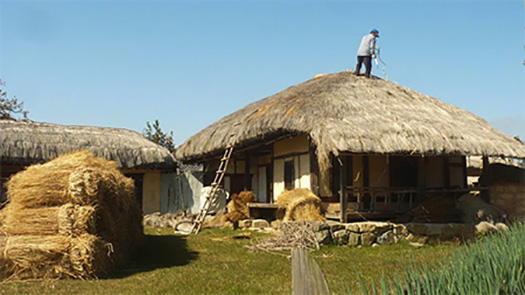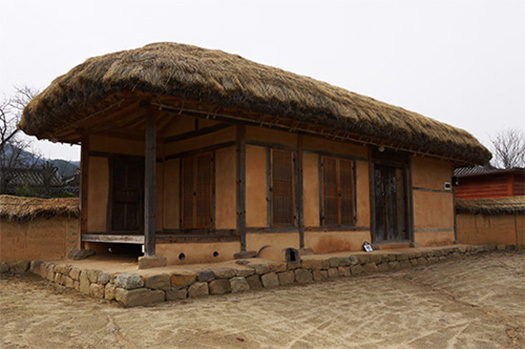

河回村ハフェマウルの住宅見学記を書き続けていると
自然と韓国の伝統家屋「韓屋」についての探究も並行してくる。
現代での韓屋の研究論文も発見できました。
「近年の韓国における木造住宅生産に関する研究」
-全羅南道・幸福村プロジェクトの木造住宅施工業者に着目して-
主査 権藤智之首都大学東京准教授、蟹澤宏剛芝浦工業大学教授、
東大の研究員の金善旭・金容善の2人。合計4名の名が記載されている。
日本語で書かれた論文で日本の研究者が中心ですが、
研究スタッフには韓国人名も。日本に留学の研究者たちのようです。
韓国では戸建て住宅ではなく集合住宅マンションが多数派住宅であり
戸建て木造住宅は一時期1%以下というレベルまでシェア低下したようです。
そもそも2001年以前では木造住宅着工数の国家統計すら見られないという。
統計公開の2002年に481棟から2011年で6425棟と10年で10倍以上に増加。
住居建築着工数に占める木造割合も2002年の0.77%から2011年の8.24%に。
2010年以降ではシェアは9.85%とほぼ1割ほどを占めてくるようになっている。
そういう木造戸建てでもツーバイフォーが主体のようです。
木造技術者の衰微も甚だしくこうした洋屋住宅でも産地国の技術者たちが
わざわざ出張滞在して建てられていたということだそうです。
工法別に国家統計調査もされていなくて、手探りのようにして
韓国の伝統的木造軸組構法住宅である韓屋の意匠と、プレカットなど
現代的な技術を組み合わせた住宅開発を進めているとされる。
地方自治体の地域振興策として韓国南西部・全羅南道で2007年に始まった
「幸福村」事業により全羅南道では年間数百棟規模で木造軸組構法住宅が
供給されている。そのなかで韓屋型の木造軸組構法住宅、大工職人や木材流通、
制度まで含めて木造軸組構法住宅がどう供給されているか解明。文中
「国土海洋部推定で木造軸組構法住宅年間着工数は1000棟程度」との記述。
韓国国内での伝統工法住宅の状況が知れてきます。
先般、中国での木造軸組構法住宅についての情報もあったけれど、
韓国国内での状況を見ると、在来木造技術は市場性があると思われます。
この河回村が世界遺産に指定されて一種のモデルハウス機能を果たしてもいる。
わたしたちが訪れたときにも体験宿泊韓屋で欧米人が喜んでいた(笑)。
韓国国内でも韓屋への研究はあまり進んでいないようで、この日本の論文が
そうした分野の嚆矢ともいえるようです。このあたりも興味深い。
この韓屋に関しての社会システム再構築については
先述のように「全羅南道」という地方政府が主導しているようで
国家はそれに後追いしているような状況が見られる。
なにやら、北海道と国土交通省との住宅性能についての関係に近似する。
住宅という領域では地域の主体性が不可欠なのかも知れませんね。
写真は河回村での草葺き屋根工事の様子。
残っていた伝統工法技術者たちの施工手順などをベースにして
進行している様子が見られる。
屋根の勾配や仕様など、日本の茅葺き屋根技術とは違いがあると感じる。
技術はいったん失われると復元には相当の時間がかかるとも言われる。
中国での木造技術復元も日本の国交省が復興技術支援したというのですが、
どうやら韓国についてもそういう交流が不可欠のように思われますね。
English version⬇
[Korean wooden construction method “Hanok” social restoration situation Korea Hafemaul recollection-15]
If you continue to write a house tour of Hahoe Village
The quest for nature and the traditional Korean house “Hanok” will also be carried out in parallel.
I was also able to discover a modern Hanok research treatise.
“Recent research on wooden house production in Korea”
-Focusing on the wooden house contractor of the Jeollanam-do / Happiness Village Project-
Tomoyuki Gondo, Associate Professor, Tokyo Metropolitan University, Hirotake Kanizawa, Professor, Shibaura Institute of Technology,
Two researchers at the University of Tokyo, Asahi Kim and Yozen Kim. A total of four names are listed.
The treatises are written in Japanese and are mainly Japanese researchers.
The research staff also has Korean names. It seems to be researchers studying abroad in Japan.
In South Korea, condominiums are the majority rather than single-family homes.
It seems that the market share of detached wooden houses has dropped to a level of 1% or less for a while.
In the first place, it is said that even national statistics on the number of wooden house starts cannot be seen before 2001.
From 481 buildings in 2002 when the statistics were released to 6425 buildings in 2011, the number has increased more than 10 times in about 10 years.
The ratio of wooden construction to the number of housing construction starts also increased from 0.77% in 2002 to 8.24% in 2011.
Since 2010, the market share has reached 9.85%, accounting for almost 10%.
Even in such a wooden house, it seems that two-by-four is the main subject.
The decline of wooden engineers is also remarkable, and even in such Western-style houses, engineers from the producing countries
It is said that it was built on a business trip.
There is no national statistical survey for each construction method, so it’s like groping
The design of Hanok, which is a traditional Korean wooden frame construction house, and precuts, etc.
It is said that it is promoting housing development that combines modern technologies.
Started in 2007 in Jeollanam-do, southwestern Korea, as a regional promotion measure for local governments
Due to the “Happiness Village” project, hundreds of wooden framed houses will be built in Jeollanam-do every year.
It is being supplied. Among them, Hanok-type wooden frame construction method housing, carpenters and timber distribution,
We are clarifying how wooden framed houses are supplied, including the system. In the text
According to the Ministry of Land, Transport and Maritime Affairs, the annual number of construction starts for wooden frame construction houses is about 1000.
The situation of traditional construction housing in Korea will be known.
Recently, there was information about wooden framed houses in China,
Looking at the situation in Korea, it seems that traditional wooden technology is marketable.
Since this village is designated as a World Heritage Site, it also functions as a model house.
Westerners were delighted at the experience-based lodging Hanok when we visited (laughs).
It seems that research on hanok has not progressed much in Korea, and this Japanese treatise
It seems to be the beginning of such a field. This area is also interesting.
Regarding the reconstruction of the social system for this hanok
As mentioned earlier, it seems that the local government called “Jeollanam-do” is taking the lead.
It seems that the nation is following it.
Somehow, it approximates the relationship between Hokkaido and the Ministry of Land, Infrastructure, Transport and Tourism regarding housing performance.
Local independence may be indispensable in the area of housing.
The photo shows the thatched roof construction in Andong Hahoe Village.
Based on the construction procedures of the remaining traditional construction engineers
It can be seen that it is progressing.
I feel that there are differences from Japanese thatched roof technology, such as the slope and specifications of the roof.
It is said that once the technology is lost, it will take a considerable amount of time to restore it.
It is said that Japan’s Ministry of Land, Infrastructure, Transport and Tourism also provided reconstruction technology support for wooden technology in China.
It seems that such exchanges are indispensable for South Korea as well.
Posted on 9月 2nd, 2021 by 三木 奎吾
Filed under: 住宅マーケティング, 住宅性能・設備, 海外住宅事情







コメントを投稿
「※誹謗中傷や、悪意のある書き込み、営利目的などのコメントを防ぐために、投稿された全てのコメントは一時的に保留されますのでご了承ください。」
You must be logged in to post a comment.